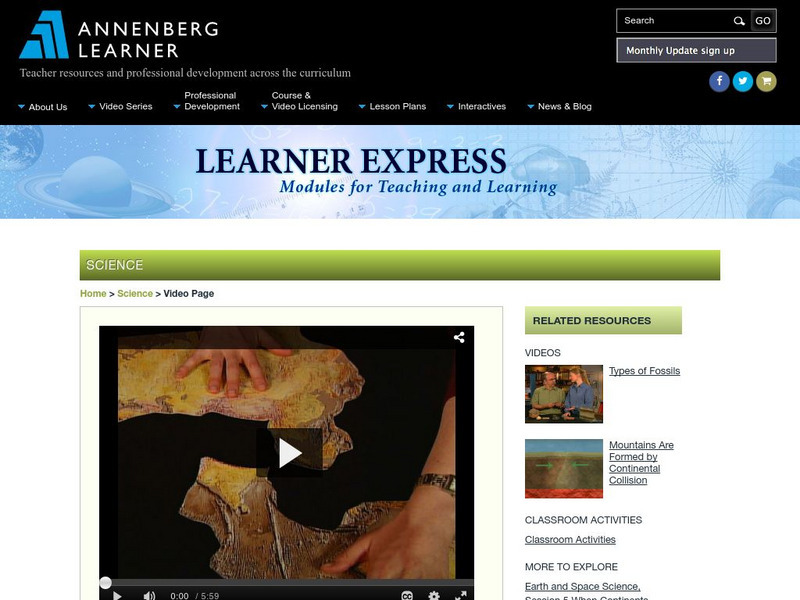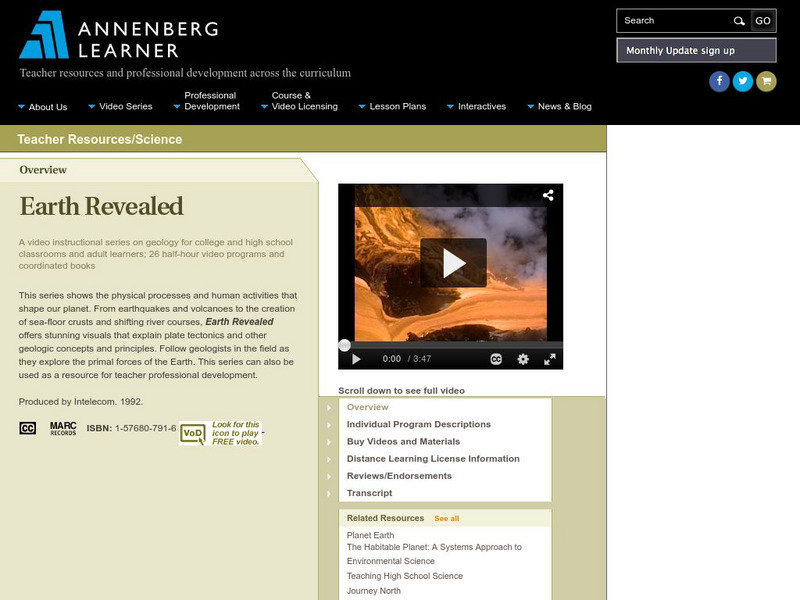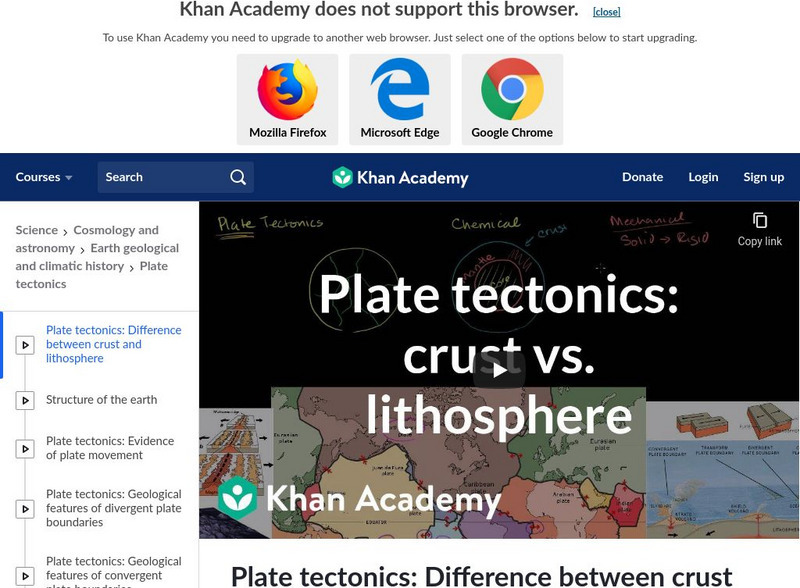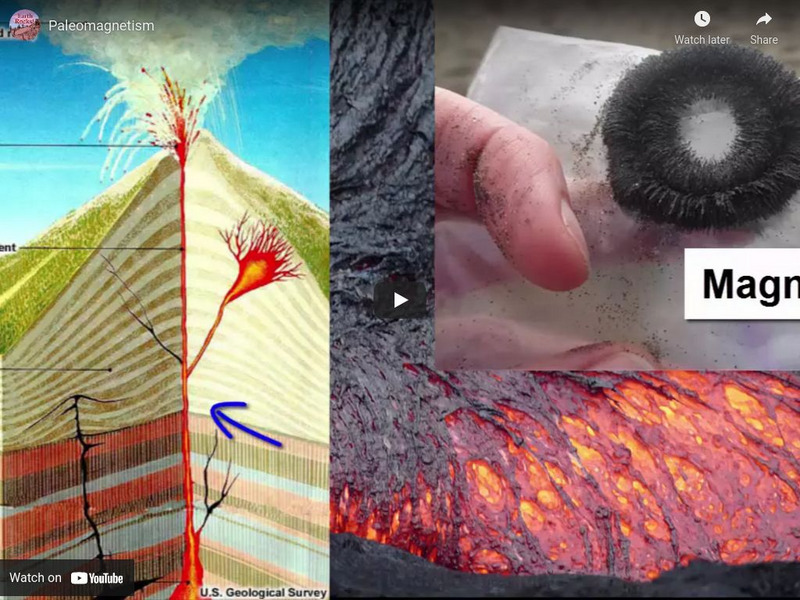Hi, what do you want to do?
Khan Academy
Plate Tectonics: Difference Between Crust and Lithosphere, Cosmology and Astronomy
Explore the tectonic plates that make up the surface of our Earth and their movement, as well as the terminology of the Earth's structure.
Curated OER
Mid Ocean Ridges, Volcanoes, and the Arctic
Journey underwater for a better look at the tectonic plates and the volcanoes they create. Although this video is slightly dry, it is packed with valuable information and easy-to-understand visual images. Consider using a portion to...
Curated OER
Earth 100 Million Years From Now
100 million years and counting. See how the earth has changed over the past 100 million years. An image rich clip narrated not by voice but by explanatory text for learners to read. They listen to a dynamic music score, watch the earth...
Curated OER
The Solid Earth - Environmental Science
What is the solid part of the earth and how does it effect our environment? Professor Paul Tackley explains how the active, solid part of the earth is responsible for volcanoes, earthquakes, and plate tectonics. He uses solid examples...
PBS
Pbs Learning Media: Plate Tectonics: Lake Mead, Nevada
Using animations to illustrate the theory of plate tectonics, this video segment adapted from Discovering Women takes you to Lake Mead, Nevada, to see visual evidence of how plate movement has been stretching the North American...
PBS
Pbs Learning Media: Plate Tectonics: Further Evidence
This video segment [2:12] adapted from A Science Odyssey uses animation and archival footage to provide an overview of the theory of plate tectonics.
PBS
Pbs Learning Media: Plate Tectonics: The Hawaiian Archipelago
This video segment adapted from NOVA uses animation to show the relationship between the movement of a tectonic plate and whether volcanoes on the Hawaiian Islands are active or dormant. 4m 38s
PBS
Pbs Learning Media: Doomsday Volcanoes Clues Inside a Volcano
Are three seemingly separate volcanoes in Iceland actually connected to each other? For the first time, scientists can study a volcano from the inside and find out that these volcanoes are actually connected. Find out how in this video...
PBS
Pbs Learning Media: Treasures of the Earth When Did Plate Tectonics Begin?
When you hear the word "diamonds" what comes to mind? Rings, necklaces, earrings? How about plate tectonics? Believe it or not, the minerals in diamond inclusions have helped scientists understand when the process of plate tectonics...
Monterey Institute for Technology and Education
National Oceanic and Atmospheric Administration: Plate Tectonics
This resource provides a video about plate tectonics.
Monterey Institute for Technology and Education
National Oceanic and Atmospheric Administration: Mid Ocean Ridges
Watch a video depicting the formation of a mid-ocean ridge. The resource also has two additional lessons requiring you to apply your knowledge of mid-ocean ridge location and formation.
Monterey Institute for Technology and Education
National Oceanic and Atmospheric Administration: Subduction Zones
This video explains the process of subduction between two oceanic plates as well as a continental plate and oceanic plate. Links to two additional subduction activities are also available.
Annenberg Foundation
Annenberg Learner: Learner Express: Plate Tectonics
Learn why there are seashells on top of Mount Everest in this video that explores plate tectonic activity. [5:59]
Annenberg Foundation
Annenberg Learner: Metamorphic Rocks: Why Rocks Bend and Fold: Part 1
Explore rock layers with scientist to learn how forces cause sedimentary rock changes into metamorphic rock in the video. [8:53]
Annenberg Foundation
Annenberg Learner: Mountain Building: A Tug of War
Learn how mountains are formed from below by tectonic forces in this video. [2:42]
Annenberg Foundation
Annenberg Learner: Mountains Are Formed by Plate Collision
Investigate how mountain ranges form by collisions of continental plates in this video. [1:49]
Annenberg Foundation
Annenberg Learner: Earth Revealed
To support or supplement a course in earth science or geography, Annenberg Media offers twenty-six Videos on Demand (VoDs). The topics coverd range from why Earth can sustain life, to plate tectonics, to rock types and landscape...
Smithsonian Institution
National Museum of Natural History: Qrius: Volcano Geochemistry Windows to Earth's Interior
Geologist Dr. Elizabeth Cottrell, describes why she considers volcanoes "lungs of the earth" in this webcast. [29:15]
BioEd Online
Bio Ed Online: The Rock Cycle and Plate Tectonics
Earth's crust is altered by two closely related dynamic processes: the rock cycle and plate tectonics. In combination, these processes continually recycle and remodel Earth's solid surface, and reshape its oceans and rivers. [37:53]
Incorporated Research Institutions for Seismology
Iris: Solomon & Vanuatu Islands: Earthquakes & Tectonics
Islands in the south Pacific are recognized for particular features which nurture earthquakes. A video will illustrate tectonic microplates found in the region. [4:09]
Khan Academy
Khan Academy: Plate Tectonics: Difference Between Crust and Lithosphere
The instructor explores the plates in the makeup of Earth's surface. Evidence and theories about plate tectonics are featured. [8:00]
Other
City College of San Francisco: Earth Rocks!: Paleomagnetism
Brief review of paleomagnetism, specifically their role in better understanding Plate Tectonics. [8:35]
PBS
Pbs Learning Media: Plate Tectonics: An Introduction
This video segment adapted from Discovering Women uses animations to introduce the theory of plate tectonics and to explain why earthquakes occur and how continents form. 2m 21s
PBS
Pbs Learning Media: A Land Born in Fire
In this Nature video, follow geologists as they retrieve samples from a fresh batch of Kilauea's molten lava. [5:25]





















